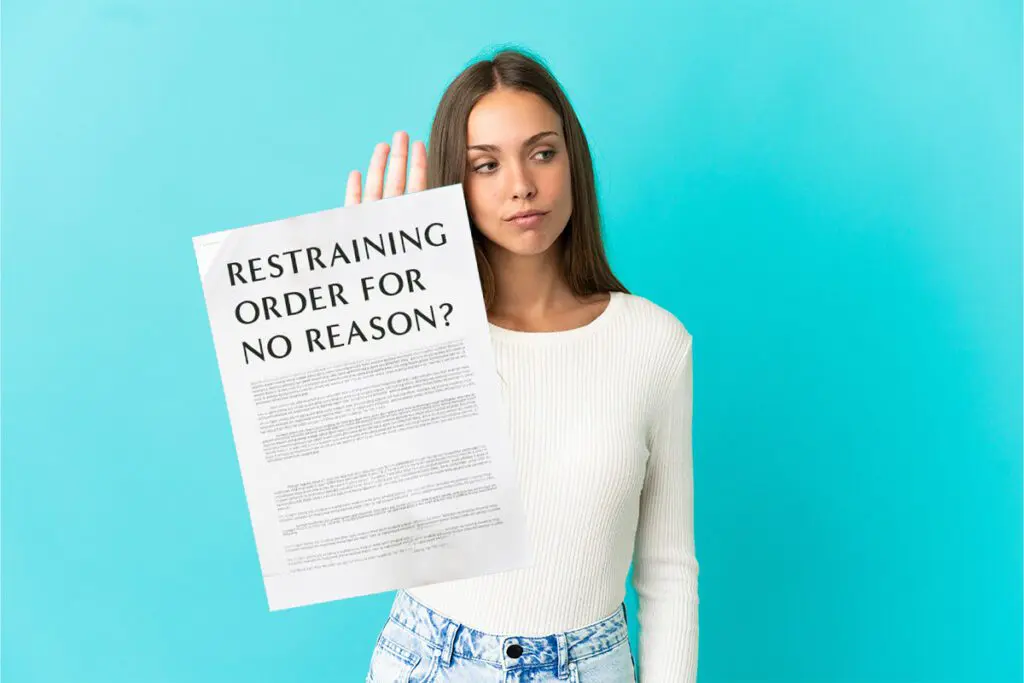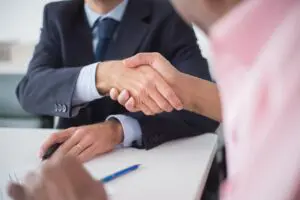No, you cannot obtain a restraining order against someone for no reason. To get a restraining order, you must show that you have been threatened or are in reasonable fear of imminent serious harm. Valid reasons for obtaining a restraining order include causing or attempting to cause physical injury, domestic violence, harassment, stalking, or other forms of threatening behavior. The criteria for obtaining a restraining order may vary by jurisdiction, but it always requires a valid reason, such as a threat of harm or actual harm.
While some believe you can restrict someone’s freedom and get a court order at the drop of a hat, in reality, these protection orders are not handed out so easily. Restraining order will go on the persons record, either temporarily or permanently. They require legitimate concerns for safety and specific criteria that must be met. Duncan Family Law is here to clear up the confusion and shed light on what actually warrants such serious legal action.
Understanding Restraining Orders
Legal Grounds
Restraining orders require a legal basis. Courts do not grant them without cause. The person filing for the order must show they have a reasonable fear or provide evidence of a threat.
A judge will ask for facts that shows protection is necessary. If someone threatens you or acts violently, this could be grounds for an order. You cannot get one “just because” or out of spite.
Purpose and Function of a domestic violence restraining order
The main goal is to prevent harm or harassment to the victim. This court order helps keeping the petitioner safe from another persons potential harm.
These orders legally limit how two people can interact. They may not be able to call, text, visit, or even come near them in some cases.
Types and Scope
There are different kinds of restraining orders:
- Personal conduct orders stop specific actions like calling.
- Stay-away orders set physical distance limits.
- Residence exclusion (“kick-out” or “move-out”) orders require the respondent to move out from where the petitioner lives.
The scope changes based on where you live and your situation. Some might only apply while at home; others include work, school, and public places too.
Valid Reasons for a Restraining Order
Proving Harm
To get a protective order, harm or threat of harm must be proven. Courts need evidence that someone’s safety is at risk. This isn’t easy. The law often wants clear and convincing proof.
You can’t just say you feel scared, you have to show why. Maybe there are texts where someone threatened you, or perhaps someone hurt you before.
Records help judges see the danger is real. Without them, getting a restraining order might not be possible.

Documenting Domestic Abuse
If abuse happens, collect any type of evidence.
- Photos of any injuries.
- Texts or emails with threats.
- Call logs showing frequent unwanted contact.
These records make your case stronger: The more details these records have, the better they can prove the abuse.
Witness Statements
If others witnessed the abuse, their words can help you in court:
- A neighbor hears fights and sees bruises later.
- A friend gets texts asking for help.
- Co-workers notice marks on your arms.
Witnesses can provide written statements or testify in court. Their honesty adds weight to your claim for protection through a court order.

The Process of Obtaining a Restraining Order
Filing Procedures
To start the restraining order process, petitioners or their law office must fill out and file legal forms with the court. It’s important to complete these forms correctly to avoid any delay.
Evidence Submission
When filing for a restraining order, bring all evidence with you. This includes any proof of abuse or stalking that has occurred. Photos and messages could be key pieces of evidence. Witness statements also strengthen your case.
Legal Representation
Having a domestic violence attorney will help you navigate through this complex process. While not required, they come recommended for their expertise in such matters.
Lawyers know how to present cases effectively in court which can increase chances of success in obtaining a restraining order.
Emergency and Temporary Orders

Immediate Protection
Emergency protective orders (EPOs) or temporary restraining order can be a shield when danger looms. These orders are quick to get and a judge can issue them without the abuser being present. This is key in urgent situations like domestic violence where waiting isn’t safe from physical harm.
In domestic violence cases, a judge looks at the preliminary evidence in order to issues a protective order to the person filing asap. It could be phone calls, text messages, medical records, present evidence of mental abuse, They might grant an EPO if they believe there’s immediate risk of harm in a domestic violence case. The goal of these temporary restraining orders is to provide the protected person safety right away, even before a full court hearing happens.
Temporary restraining orders (TROs) work similarly but last a bit longer than EPOs. They keep the victim safe until the court decides on a permanent order.
Ensuring Continued Safety Beyond Immediate Threats
Following the initial consultation and issuance of emergency protective orders, the court considers moving towards a final hearing and a permanent protective order. In cases involving grave concerns like sexual assault or when there is a present danger to the victim or close family member, a criminal defense lawyer or any form of legal assistance is recommended. A law office can help the protected person to file a protective order in no time
During this period, it is crucial to restrict the freedom of the restrained person, especially concerning their access to personal property and contact with protected people. Protective orders, often extended in the final hearing, aim to safeguard the victim from further harm.
In these scenarios, the court meticulously examines all evidence, including text messages and records of past incidents, to ascertain the ongoing risk to the victim. The law mandates a specific time limit for these temporary restraining ordermeasures, with the understanding that complicated issues might need resolution at a later date.
The ultimate goal is to protect the victim, ensuring they are not exposed to immediate or present danger while the legal process unfolds. The final hearing is pivotal, as it determines the long-term restrictions on the person named in the order, solidifying the protective measures initially granted.
Duration and Limitations

A restraining order don’t last forever; they have an end date. It’s important for a victim to know this because it affects their safety plans for the future.
The law sets these time frames, which vary depending on location and case details. Some might last days while others could extend for years.
Understanding the limitations of each order helps in planning how to stay safe over time.
Evidence for a Restraining Order
Documentation Required
To file for a restraining order, certain documents are crucial. You need to show who you are with valid identification. This helps the court know both parties involved. Also, your relationship with the restrained person must be clear. Are they family, an ex-partner, or someone else?
You must fill out official forms too. They have to be accurate and complete. If there’s a mistake, it could delay things or cause problems later.
Physical Evidence
If there’s been harm, it’s key to have proof like medical reports or photos of injuries. These show the court what happened in a clear way.
Also important is evidence of any destroyed things that belong to you because of abuse. It makes your case stronger when you can actually see the damage done.
Testimonies and Statements
Your own words about what happened matter a lot in court. When you tell your story directly, it gives life to your request for protection.
Others can help by giving written statements called affidavits that say they saw or know about the abuse too. The more people who share similar stories about what happened, the better chance you have at convincing others that your side of the story is true.
Legal Consequences of Non-Compliance
Violation Implications
If someone ignores a restraining order, they face serious trouble. Police can arrest them. Courts might also make them pay fines. The punishment depends on where it happens and how bad the violation is.
The situation has the potential to rapidly deteriorate, and a breach of a restraining order can lead to a criminal record have serious consequences. When an individual violates such an order, it is not merely a disregard of a personal request; it is a legal infraction against a court-issued mandate. This action can result in the violator facing criminal charges, which may lead to an arrest, a criminal record, and possibly jail time depending on the severity and circumstances of the violation.
For example, if a person contacts someone they shouldn’t, this could lead to their arrest. It’s important to tell the police right away if this happens. This helps make sure the person follows the rules of the order.
Modifying or Terminating an Order
Changing Conditions
Courts understand that life is unpredictable. Modifications to restraining orders are sometimes necessary. If threats become more serious, the person protected can ask for changes. They must show the court new evidence or changed circumstances.
For example, if someone gets threatening texts after getting a restraining order, they might need stronger protection. They would go to court and explain why their current order isn’t enough.
Respondents have rights too. They can try to change the order through legal ways. Maybe they’ve gone through counseling or moved far away from the petitioner. These actions could be reasons to lessen restrictions.
Dissolution Criteria
A restraining order won’t last forever without a judge’s decision. It ends on its own when time runs out unless the court says it should continue longer.
Before an order expires, either side may ask for it to end early with good reasons. The court looks at whether there is still danger before canceling an order early. Imagine someone feels safe again because their harasser moved abroad permanently. They might want to remove the restraining order since there’s no threat anymore.
Who Can Apply for a Restraining Order
Eligibility Requirements
Anyone feeling threatened may wonder, “Can you get a restraining order for no reason?” The answer is nuanced. Eligibility to apply hinges on the relationship with the respondent. Typically, family members or intimate partners can request one. This includes spouses, ex-spouses, and those in dating relationships.
States have their own laws for restraining orders. You must meet these criteria before applying. For example, proof of harassment or harm might be necessary. Minors often need an adult’s help to file a request.
Protective vs. Restraining Orders
There’s confusion between protective and restraining orders. Protective orders are usually broad and cover domestic violence specifically. They aim at safeguarding a victim from abusers within close relationships.
Restraining orders vary more in use; they can relate to stalking or general harassment outside intimate settings as well. While terms differ by region, both types offer similar legal protection against harm or unwanted contact.
Understanding these differences is crucial when seeking the right type of order for your situation.
What to Expect When Filing for a Restraining Order
Court Procedures
Once you apply for a restraining order, the court sets up hearings. Here, both parties must usually show up. You will have to present your case in front of a judge.
During the hearing, you provide evidence and maybe bring witnesses. They can tell the judge about what happened. Lawyers might argue on both sides too. The judge listens carefully to everything.
The decision comes down to evidence strength. It’s called “preponderance of evidence”. This means whichever side has more convincing proof may win.
Duration and Renewal
A restraining order does not last forever. A judge decides how long it lasts at first. If threats keep happening, you can extend it.
To renew it, file another petition near when your current one is going to expire. Show that there’s still danger or fear from the person you’re protected from.
If you don’t renew on time, your protection goes away automatically.
Final Remarks
Getting a restraining order isn’t a walk in the park, and certainly not something you can snag without cause. Remember, it’s all about safety first; there’s no room for playing games with this legal shield. If someone’s giving you nightmares or worse, know that the law’s got your back. But keep it real: you need solid evidence and a genuine need for protection to make it stick.
Done reading and think you’ve got grounds for a restraining order? Don’t sit on it. Reach out to Duncan Family Law today and let us help you navigate these choppy waters. We’ll break it down for you, step by step, so you can breathe easy knowing you’re not alone in this fight. Your safety is no joke, so if you’re feeling threatened, take action now.
Frequently Asked Questions
Can you get a restraining order for no reason?
No, you can’t. A valid reason, such as threats, harassment, or abuse, is required to obtain a restraining order.
What are some valid reasons for obtaining a restraining order?
Valid reasons include stalking, domestic violence, assault, or any form of repeated harassment that makes you fear for your safety.
How do I start the process of getting a restraining order?
You begin by filing a petition at your local court and providing evidence that supports your need for protection.
Is it possible to get an emergency restraining order quickly?
Yes. Emergency orders can be granted on short notice if there’s immediate danger.
What kind of evidence do I need for a restraining order?
The evidence needed to file a restraining order could be texts messages, emails, medical records, photos of injuries or damage property—anything that shows you’re being threatened or harmed.
What happens if someone violates a restraining order?
Violating an order can lead to arrest and criminal charges. It’s taken seriously by law enforcement.
Can anyone apply for a restraining order?
Generally speaking yes—if they believe they’re in danger from another person; this includes minors with adult assistance.
Can my ex get a restraining order for no reason?
No, your ex partners can only obtain a restraining order if they have been a victim of domestic abuse, harassment, stalking, or other threatening behaviors. The specific criteria for obtaining a restraining order may vary by location, but generally, the individual seeking the order must demonstrate a legitimate threat to their safety or well-being.
Do you need a reason to get a restraining order?
Yes, a person needs a valid reason to obtain a restraining order. Common reasons for seeking a restraining order include being a victim of domestic abuse, harassment, stalking, or facing threats to safety or well-being. For example, in a divorce procedure, a restraining order can be obtained to prevent an ex-spouse from contacting or approaching the individual, especially in cases involving a threat of physical or psychological violence






